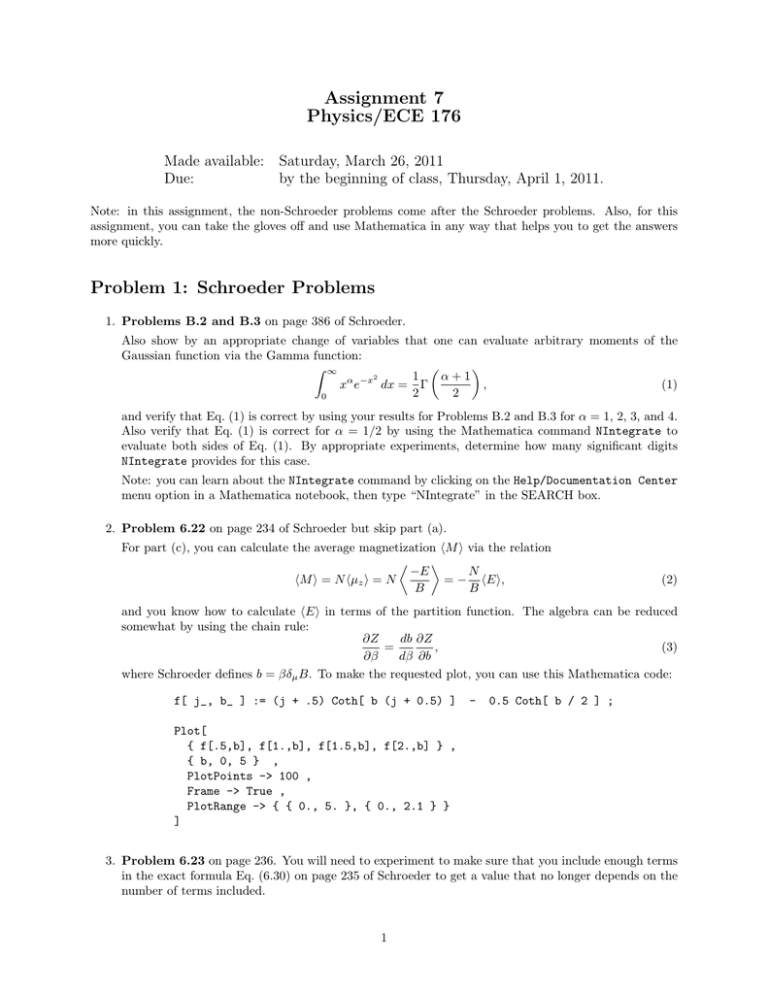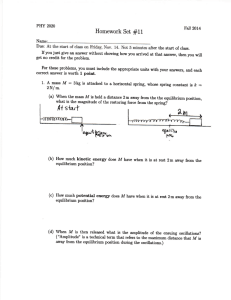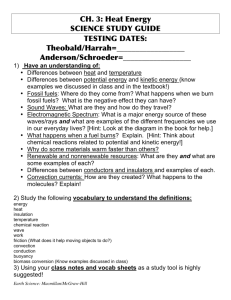Assignment 7 Physics/ECE 176 Made available: Saturday, March 26, 2011
advertisement

Assignment 7
Physics/ECE 176
Made available: Saturday, March 26, 2011
Due:
by the beginning of class, Thursday, April 1, 2011.
Note: in this assignment, the non-Schroeder problems come after the Schroeder problems. Also, for this
assignment, you can take the gloves off and use Mathematica in any way that helps you to get the answers
more quickly.
Problem 1: Schroeder Problems
1. Problems B.2 and B.3 on page 386 of Schroeder.
Also show by an appropriate change of variables that one can evaluate arbitrary moments of the
Gaussian function via the Gamma function:
Z ∞
1
α+1
α −x2
x e
dx = Γ
,
(1)
2
2
0
and verify that Eq. (1) is correct by using your results for Problems B.2 and B.3 for α = 1, 2, 3, and 4.
Also verify that Eq. (1) is correct for α = 1/2 by using the Mathematica command NIntegrate to
evaluate both sides of Eq. (1). By appropriate experiments, determine how many significant digits
NIntegrate provides for this case.
Note: you can learn about the NIntegrate command by clicking on the Help/Documentation Center
menu option in a Mathematica notebook, then type “NIntegrate” in the SEARCH box.
2. Problem 6.22 on page 234 of Schroeder but skip part (a).
For part (c), you can calculate the average magnetization hM i via the relation
−E
N
hM i = N hµz i = N
= − hEi,
B
B
(2)
and you know how to calculate hEi in terms of the partition function. The algebra can be reduced
somewhat by using the chain rule:
∂Z
db ∂Z
=
,
(3)
∂β
dβ ∂b
where Schroeder defines b = βδµ B. To make the requested plot, you can use this Mathematica code:
f[ j_, b_ ] := (j + .5) Coth[ b (j + 0.5) ]
-
0.5 Coth[ b / 2 ] ;
Plot[
{ f[.5,b], f[1.,b], f[1.5,b], f[2.,b] } ,
{ b, 0, 5 } ,
PlotPoints -> 100 ,
Frame -> True ,
PlotRange -> { { 0., 5. }, { 0., 2.1 } }
]
3. Problem 6.23 on page 236. You will need to experiment to make sure that you include enough terms
in the exact formula Eq. (6.30) on page 235 of Schroeder to get a value that no longer depends on the
number of terms included.
1
4. Problem 6.32 on pages 240-241. This problem is rather satisfying in that you are able to relate an
abstract microscopic property of a crystalline solid, the potential energy of how two particles interact, to
an easily measurable macroscopic property, the linear thermal expansion coefficient. Some comments:
• For part (b), make the substitution y = x − x0 in the integral for x (bottom of page 240). Also
recall that integrating an odd function over the real line −∞ < x < ∞ must give zero (why?).
• For part (c), Schroeder’s suggestion “assume that the cubic term is small, so its exponential can
be expanded in a Taylor series” means to write
2
3
2
(4)
e−βx ≈ e−β [u0 +ay +by ] ≈ e−βu0 e−βay 1 − βby 3 ,
where u0 = u(x0 ) and y = x − x0 . After looking for odd functions in the integrand that can be
dropped since they contribute zero, you will end up with some moments of Gaussian integrals
that you can evaluate via Eq. (1) above.
• For part (d), make your life easy by using the Mathematica command Series to evaluate the
Taylor series of the Lennard-Jones potential symbolically about x = x0 like this:
LJpotential = u0 ( (x0/x)^12 - 2 (x0/x)^6 )
Plot[ LJpotential /. {u0 -> 1, x0 -> 1} , { x, 0.8, 2 } ]
LJseries = Series[ LJpotential , { x, x0, 2.5 } ]
You can then read off the coefficients a and b needed for Eq. (4) above from LJseries.
5. Problem 6.34 on page 246.
6. Problem 6.36 on page 246. Hint: Eq. (1) above.
7. Problem 6.38 on page 246. The Mathematica command NIntegrate is useful here.
8. Problem 6.41 on page 247.
For the 3D speed√distribution,
p
√the rms speed vrms , the average speed v, and the most likely speed vmax
are in the ratio 3 : 8/π : 2 ≈ 1.22 : 1.13 : 1. What is the corresponding ratio vrms : v : vmax
for the 2D gas?
Problem 2: Some quantitative details of the DNA-like zipper model
In this problem, you continue the Quiz 4 problem related to formation or unwinding of a two-strand DNAlike molecule by working out some quantitative details. Recall that the quiz problem introduced a simple
zipper-like model of a biomolecule
that has N links such that each link is closed with energy 0 or open with energy > 0. The zipper can
unzip only from one side (say from the left as shown above) and the nth link from the left can open only if
all the links to the left of it (1, 2, . . . , n − 1) are already open. The N th link on the right is always closed.
The zipper is assumed to be in equilibrium with a surrounding reservoir with constant temperature T .
2
1. Use the partition function for this zipper model to show that the average number of open links hni as
a function of temperature is given by the expression:
hni =
N
1
− N β
.
−1 e
−1
eβ
(5)
Hint: 1 + x + . . . + xK−1 = (1 − xK )/(1 − x).
2. Calculate the leading-order functional behavior of Eq. (5) in the limit of small temperatures kT and of high-temperatures kT . Use Mathematica to plot (as a function of the variable kT /) and
so compare your two limiting behaviors with the exact answer Eq. (5) for N = 10 and discuss whether
your plot for hni makes scientific sense.
Hint: “leading-order functional behavior” means to do some kind of expansion in powers of a small
quantity until you find (and include) the first non-constant term.
Problem 3: A Box With A Tiny Cold Plate, Revisited
Redo Problem 2 of Assignment 2 for the most realistic case of isotropic molecular velocities and a Maxwell
speed distribution by obtaining an analytical expression for the power dE/dt delivered by colliding molecules
to a small cold plate of area A on the side of a vessel that contains an ideal equilibrium gas at temperature T .
Discuss briefly how your answer differs from Eq. (4) of Assignment 2: does one gain much quantitative
accuracy by using a speed distribution, compared to assuming all speeds are the same speed v = vrms ?
Hint: The kinetic energy dE delivered to the area A over a short time ∆t by all molecules with speeds in
a range [v, v + dv] along the θ, φ coordinate line of a spherical coordinate system centered on the area A is
given by
N
sin(θ) dθ dφ 1
dE = A[(v cos(θ))∆t] ×
×
× mv 2 × D(v) dv,
(6)
V
4π
2
where the last factor, D(v) dv, is the new part of this problem and gives the fraction of molecules with a
speed v in the range [v, v + dv].
Alternatively, Eq. (6) could be derived more directly by observing that dN ≈ Av cos(θ)∆t×(N/V )×D(v) d3 v
gives the number of molecules that will strike the area A in time ∆t with a particular velocity vector v,
where D(v) = (m/(2πkT ))3/2 exp(−βmv 2 /2) is the Maxwell velocity distribution (not speed distribution).
Changing this expression to spherical coordinates, d3 v → v 2 sin(θ) dv dθ dφ, leads to the same result.
Problem 4: Speed versus energy distribution of an equilibrium gas
In the context of discussing velocities and speeds of molecules in a gas that is thermodynamic equilibrium
with constant temperature T , we have discussed probability densities (also called distribution functions) like
the Maxwell speed distribution D(v) (Eq. (6.50) in Schroeder on page 244 of Schroeder) that give the relative
probability of some quantity like the molecular speed v to take on some value.
One has to be a bit careful in using a distribution that describes one variable, say the speed v of a molecule, to
gain intuition about the properties of some other variable that might depend on v. For example, because there
is a range of molecular speeds in an equilibrium gas, there is a corresponding range of kinetic energies E =
(1/2)mv 2 . Is it the case that the most likely kinetic energy Emax is given by the most like speed vmax (using
2
Schroeder’s notation, see the bottom of page 244) so Emax = (1/2)mvmax
?
Explore this situation by calculating directly the most likely kinetic energy Emax for molecules in an equilibrium ideal gas. Do this in two steps:
3
p
1. From E = (1/2)mv 2 we have v = (2/m)E. Now change variables v → E in the normalization
condition for the Maxwell speed distribution
Z ∞
1=
D(v) dv,
(7)
0
and deduce from the new integral what is the distribution function1 D(E) for the kinetic energy.
2. From your expression for the probability density D(E) for the kinetic energy of molecules in an equilibrium gas, calculate the most likely kinetic energy Emax as determined by where D(E) has a local
maximum. Is the most likely kinetic energy the one that corresponds to the most like speed vmax ? If
2
not, discuss how big is the error and why Emax is bigger or smaller than (1/2)mvmax
.
Problem 5: Time to Finish This Homework Assignment
Please tell me the approximate time in hours that it took you to complete this homework assignment.
1 It is a common but sometimes confusing practice in physics to use the same symbol to represent functions of a similar
physical meaning, with the variable indicating what specific function is being considered. Thus D(v) is the Maxwell speed
distribution but D(E) represents a different function, the distribution appropriate for the kinetic energy. A better notation
would be something like Dspeed (v) and DE (E).
4



